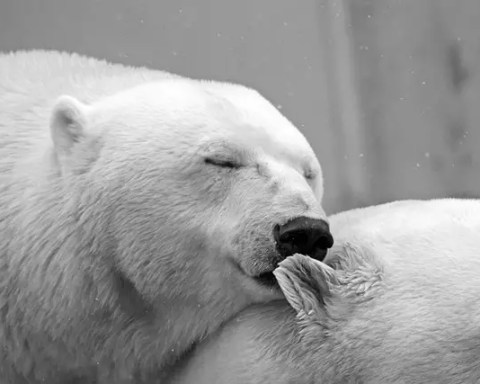People often wonder if the polar bear’s fur is white then its skin is probably white too. That is not quite true. The polar bear’s skin is jet black which is in contrast to the bear’s white fur. One can hardly see the black skin except in situations when a polar bear sheds its hair possibly due to some disease or infection. The black naked portion of the body becomes prominent for as long as it is covered by the hair again. Let’s then discover what color are polar bears actually.
What Color are Polar Bears?
Unlike adults, the polar bear cubs have pink-colored skin especially in the first 150 days. Their skin turns black with age. On the contrary, grizzly bears have pink skin not only in cubs but in adults too. That said, white bears have eventually evolved to acquire black skin in adults—probably an adaptation trait. Let us not forget that the present-day polar bears have been evolved from grizzlies. Scientists do not know the primary reason behind this change.
Back in 70s a group of scientists carried out a study in which they revealed that the bear absorbs ultraviolet light. They thought that the bear’s fur serves as a fiber optic filament in that they transmit light all the way to the skin. This is a sort of thermal warning. Andrew E. Derocher writes in his book, Polar Bears—A Complete guide to their Biology and Behavior, “Fibre optic properties of a polar bear hair appears to be less than a thousandth of a percent of the light traveled 2.5 cm (1 inch).” The loss of ultraviolet light is thought to occur in a fraction of that distance. As it turns out the theory of fiber optic fur does not stand to logic. Yet another reason is that there are certain regions in the Arctic where the sun never sets—at least 6 months a year in summer. Similarly in winter the darkness lasts for nearly half a year. During these days polar bears do not and should not retain the heat—they drive it away.
Read More: Why are Polar Bears White?
Polar bears occupy a vast range of Arctic Circle touching many territories including Russia, Denmark, Norway, Canada, and United States including Alaska. These countries have temperature that drops down below the freezing point. But polar bears are safe; thanks to the bear’s thick black skin which gathers sun-rays keeping the bear warm in cold weather.
Image Courtesy: World Wildlife Fund
Polar Bear Skin Color – What Color are Polar Bears?
It is not only the black skin that keeps the bear warm in fact there is a dense layer of fat beneath the skin which measures 4.5 inches thick. However these fats do not prevent heat loss in polar bears as they swim in the icy cold water. The heat loss is prevented by the polar bear’s fur. Furthermore the thick fatty skin and fur do not allow white bears to run longer because if they do they’d become overheated.
Read More: Why are Polar Bears White?
The fatty layer of skin functions much like a thermos in which the heat is trapped keeping the thermos warm. Polar bears are remarkable swimmers and they are able to swim for days or even months if they must. If they had to swim without blubber the body temperature would drop down.
This shows that the skin plays a significant role in defining the behavioral adaptation of polar bears. Cubs are however not protected by the blubber which is why mother bears mostly hesitate to swim with their cubs. Adult polar bears gain fats by eating seal’s blubber.
What Color are Polar Bears? – Video
YOU MIGHT LIKE TO READ?
- WHERE DO POLAR BEARS COME FROM?: The polar bear and brown seems to have one evolutionary ancestor. Scientists estimate that both species set apart during the latest glaciations…
- POLAR BEAR GENETICS: Polar bears appear to be genetically divided into discrete populations based on their geographic locations…
- POLAR BEAR METABOLISM: Polar bears are thought to use numerous physiological and behavioral mechanisms to normalize temperature…
- POLAR BEAR LIFE HISTORY & BEHAVIOR: Polar bears have long been the primary source of meat and other raw materials for indigenous people…



